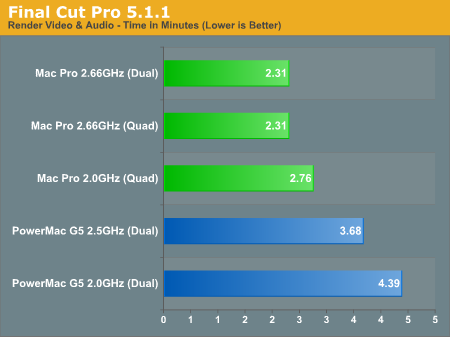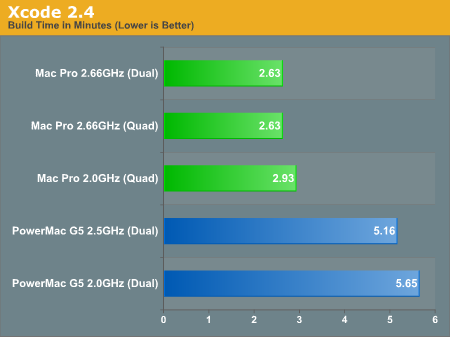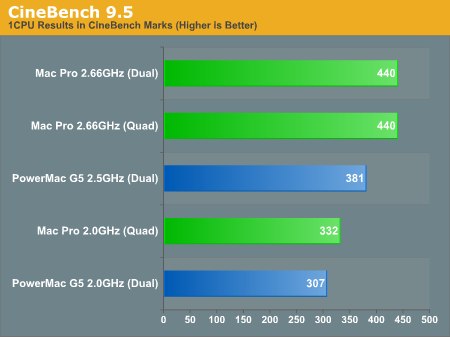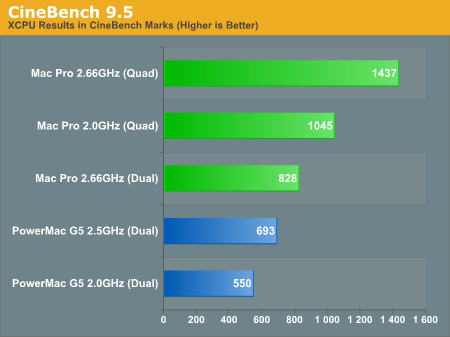Apple's Mac Pro - A True PowerMac Successor
by Anand Lal Shimpi on August 16, 2006 12:27 PM EST- Posted in
- Mac
Professional Application Performance with Final Cut Pro, Xcode and CineBench
Our first "Pro" application test uses Apple's famed Final Cut Pro 5.1.1. The test is simple, we are just rendering a video we dragged into our project:

If you spend a lot of time in Final Cut, you can't get faster than the Mac Pro. At 2.0GHz it's already faster than the PowerMac G5 (even when you extrapolate out the performance of the 2.7GHz G5).
Our next test is for all you developers out there, we're simply measuring build time using Xcode 2.4 and building our favorite OS X IM client: Adium. Compiling is very disk intensive but it's also quite CPU bound as well; while there's no benefit to quad processors when only compiling a single application there is a benefit to higher clock speeds.

The Mac Pro completely demolishes the PowerMac G5 in build time, cutting the time to build Adium almost in half. The performance improvement is tremendous and it echoes some of the feelings we've had when using Intel based Macs; anything involving I/O seems to be faster and smoother.
Our final professional benchmark is CineBench 9.5, which measures 3D rendering performance. Two versions of the benchmark are run, one that's single threaded and one that spawns as many threads as you have cores.

The single threaded test shows a reasonable advantage over the PowerMac G5, about 8% at the same clock speed. The PowerPC G5 architecture was no slouch and floating point performance was its strong point, thus even the almighty Woodcrest can't really put it to shame too much.

The multithreaded test shows the advantages of having four cores, as the Mac Pro maintains a significant lead. Note that the Mac Pro 2.66GHz held a 15.4% performance advantage over the PowerMac G5 in the single threaded test, but that grew to 19.4% in the multithreaded test. The performance scaling shows one of the advantages of Intel's shared L2 cache, making for better performance scaling when going from one to two cores.










96 Comments
View All Comments
Anand Lal Shimpi - Wednesday, August 16, 2006 - link
Could you show me how to get Dell to take $149 off for the monitor? Whenever I try to configure it if I select the "No Monitor" option it lists a cost of $0, meaning I don't gain or lose anything.The Dell protection plan is truly enterprise class however the point of the comparison was to look at things from a purely hardware/cost of components perspective, which is how these Mac vs. PC price comparisons are usually done. Once you go above and beyond that then you get into this slippery slope argument of how much you should tack on for the price of being able to run OS X, etc...
Take care,
Anand
delta53 - Wednesday, August 16, 2006 - link
The "they" was referring to Apple namely at the WWDC6, no offence Anand. The option is given under the Medium and Large business section, but your point is well taken that exact price is impossible in that section.Keep up the good reports,
Kyle
Furen - Wednesday, August 16, 2006 - link
I was under the impression that Cinebench had very light memory usage. It looks to me that what will make or break Woodcrest's "power efficiency" is going to be FBDIMM power so perhaps loading up the ram will paint slightly different numbers...TamarinMonkey - Wednesday, August 16, 2006 - link
Now that we can run both OSX and XP on the same hardware, I'd be interested to see some of the benchmarks run on both OSs and see how they do. Any plans to do this in a future article?~Tam~
retrospooty - Wednesday, August 16, 2006 - link
I am pretty sure this has been done, and OSX has been found to be lacking, especially in 3d games. The speed advantage of PC over MAC was not that Intel/AMD were so much faster than IBM G4, then G5, but the OS and drivers are much finer tuned.Tegeril - Wednesday, August 16, 2006 - link
It was definitely not so much about the OS/Drivers being finer tuned in regards to 3D gaming. It was definitely a DirectX versus OpenGL issue.psychobriggsy - Thursday, August 17, 2006 - link
More specifically, Apple's OpenGL implementation on PowerPC was/is severely lacking.I wonder if the Intel Mac OS X drivers are better - i.e., the ATI/Nvidia drivers ported to Mac OS X.
Konq - Monday, September 11, 2006 - link
I just played WoW last night on my Quadro 4500-equiped Mac Pro. An ATI version should be similar. I was in a 40 man raid for my guild. This thing screams in OS X. I get 30-40 fps in a crowded IF, 50-100 fps flying, and I peaked at 135 fps looking at the sky. All at 1920x1200. The drivers sure have improved and I think are better on intel. I have a 2.3 Ghz dual core G5 and this is twice as fast even thought the G5 had a 7800 GT card. Oh - and I never noticed the fans spin up during the raid even though I had low sound volume.Rumor has it that OpenGL will be much improved when it goes multithreaded in 10.4.8. We will see. :)
Konq - Monday, September 11, 2006 - link
I forgot to mention: the Mac Pro loaded the WoW AQ40 instance in about 2 seconds! Faster even the second time. I can't express how impressed I am with this machine.As a side note, I used Office in Rosetta, and it is as fast as my G5. Maybe 4GB of RAM helps here but I was worried after reading Anands' report.
Pirks - Wednesday, August 16, 2006 - link
Please use XP x64 benchmarks as well, since it's uberinteresting to see how both 64-bit OSes from MS and Apple compete. XP 32-bit is okay, but a bit boring.